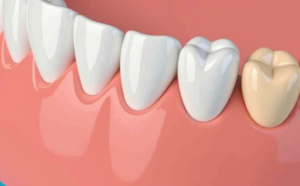Key Takeaways
- Tooth-colored fillings, also known as composite fillings, blend seamlessly with natural teeth
- Made from a mixture of plastic and glass particles, these fillings are durable and long-lasting
- Composite fillings require less tooth structure removal compared to traditional amalgam fillings
- They are suitable for both front and back teeth, making them versatile for various dental needs
- The procedure is typically completed in a single visit and is generally painless
- Proper oral hygiene and regular dental check-ups can help extend the life of tooth-colored fillings
Tooth-colored fillings are a popular and aesthetically pleasing option for treating dental cavities. These fillings, also known as composite fillings, are designed to match the color of your natural teeth, making them virtually invisible when you smile or speak. If you’re looking for a discreet way to restore your teeth after cavity treatment, tooth-colored fillings might be the perfect solution for you.
Understanding Tooth-Colored Fillings
Tooth-colored fillings have become increasingly popular in recent years due to their natural appearance and improved durability. These fillings are made from a mixture of plastic resin and fine glass particles, which allows them to closely mimic the look and feel of natural tooth enamel.
Composition of Tooth-Colored Fillings
The main components of tooth-colored fillings include:
- Resin matrix: This is the plastic part of the filling that provides flexibility and helps bond the material to the tooth.
- Glass or ceramic particles: These filler particles give the composite material strength and wear resistance.
- Coupling agents: These chemicals help the resin and filler particles bond together effectively.
- Initiators and accelerators: These components trigger the hardening process of the filling material.
The combination of these materials results in a strong, durable filling that can withstand the pressures of biting and chewing while maintaining a natural appearance.
Benefits of Choosing Tooth-Colored Fillings

There are several advantages to opting for tooth-colored fillings over traditional amalgam fillings:
Aesthetic Appeal
The most obvious benefit of tooth-colored fillings is their ability to blend in with your natural teeth. This makes them an excellent choice for visible areas of your mouth, such as front teeth or premolars. With tooth-colored fillings, you can smile confidently without worrying about noticeable metal fillings.
Preservation of Tooth Structure
Composite fillings often require less removal of healthy tooth structure compared to amalgam fillings. This conservative approach helps maintain the strength and integrity of your natural tooth, which can be beneficial for long-term oral health.
Versatility
Tooth-colored fillings can be used to treat cavities in both front and back teeth. They are suitable for small to medium-sized cavities and can even be used to repair minor chips or cracks in teeth.
Mercury-Free
Unlike amalgam fillings, which contain mercury, tooth-colored fillings are completely mercury-free. This makes them a safer option for people who are concerned about potential mercury exposure.
The Tooth-Colored Filling Procedure
Getting a tooth-colored filling is a relatively straightforward process that can usually be completed in a single dental visit. Here’s what you can expect during the procedure:
Preparation
Your dentist will start by numbing the area around the affected tooth with a local anesthetic. This ensures that you remain comfortable throughout the procedure. Once the area is numb, the dentist will remove the decayed portion of the tooth using a dental drill or laser.
Cleaning and Etching
After removing the decay, your dentist will clean the cavity thoroughly to remove any bacteria or debris. They will then apply an etching solution to the tooth surface, which creates tiny pores that help the filling material bond more securely to the tooth.
Application of the Filling Material
The composite material is applied in thin layers, with each layer being hardened using a special light. This layering technique allows the dentist to build up the filling gradually, ensuring a proper fit and shape.
Shaping and Polishing
Once all the layers are in place, your dentist will shape the filling to match your natural tooth contours. They will then polish the filling to create a smooth surface that feels comfortable in your mouth.
Caring for Your Tooth-Colored Fillings
To ensure the longevity of your tooth-colored fillings, it’s important to maintain good oral hygiene habits:
- Brush your teeth twice a day with fluoride toothpaste
- Floss daily to remove plaque and food particles between teeth
- Avoid biting or chewing on hard objects that could damage the fillings
- Visit your dentist regularly for check-ups and professional cleanings
Potential Limitations of Tooth-Colored Fillings
While tooth-colored fillings offer many benefits, it’s important to be aware of their potential limitations:
Durability
Although modern composite materials have improved significantly, tooth-colored fillings may not last as long as amalgam fillings in some cases, especially for large cavities in back teeth that experience heavy chewing forces.
Cost
Tooth-colored fillings are generally more expensive than amalgam fillings due to the higher cost of materials and the more time-consuming application process.
Sensitivity
Some people may experience temporary sensitivity to hot and cold temperatures after getting a tooth-colored filling. This usually resolves within a few weeks.
Comparing Tooth-Colored Fillings to Other Options
To help you make an informed decision about your dental treatment, let’s compare tooth-colored fillings to other common filling materials:
| Filling Type | Appearance | Durability | Cost | Mercury Content |
|---|---|---|---|---|
| Tooth-Colored (Composite) | Natural-looking | Good | Moderate to High | None |
| Amalgam | Silver/gray | Excellent | Low | Contains mercury |
| Gold | Gold-colored | Excellent | High | None |
| Ceramic | Natural-looking | Very good | High | None |
When to Consider Tooth-Colored
Tooth-colored are an excellent choice for many dental situations, but they may be particularly well-suited for:
- Visible teeth where aesthetics are a priority
- Small to medium-sized cavities
- Patients concerned about mercury exposure
- Teeth that require minimal removal of healthy structure
- Repairs to minor chips or cracks in teeth
Conclusion
Tooth-colored fillings offer a natural-looking and effective solution for treating dental cavities. With their ability to blend seamlessly with your natural teeth, these fillings can help restore your smile without compromising on aesthetics. While they may have some limitations compared to traditional amalgam fillings, the benefits of tooth-colored fillings make them a popular choice for many patients.
If you’re considering tooth-colored fillings, it’s important to discuss your options with your dentist. They can help you determine whether this type of filling is the best choice for your specific dental needs and oral health goals. You can visit our website or contact us. Remember, regardless of the type of filling you choose, maintaining good oral hygiene habits and regular dental check-ups are key to keeping your teeth healthy and your smile bright for years to come.

